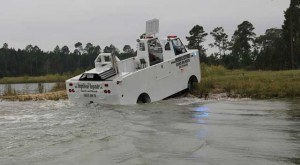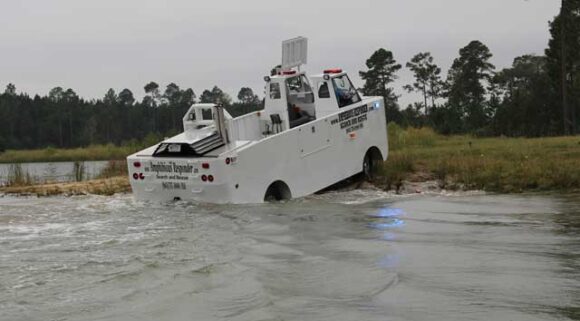A cross between a truck and a boat built by a small South Carolina company is designed to help respond in a new world of increasingly wet disasters brought on by global warming.

The Amphibious Responder, depending on configuration, can serve as everything from a fire engine to a search and rescue boat to an environmental response vehicle dealing with oil spills both on land and water.
As a rescue vehicle, it can carry 15 people and has a ladder at the front that can extend to the third floor of a building. It has a patented foam-filled hull construction making it almost impossible to sink.
With both a boat motor and a second engine to power it on land, it can speed at 70 mph down a highway, make seven knots in the water and can enter the water virtually anywhere without the need for a boat ramp. The Responder’s oversize tires make it capable of traveling across debris on land.
A few decades ago, there wouldn’t have been a market for it, says John Giljam, who designed and builds the vehicle in this small town about 30 miles north of Savannah, Ga.
“Twenty years ago a disaster was just an isolated incident,” he says. “But now there are more storms and the smaller storms are creating more havoc.”
He says the Responder is uniquely designed to handle some of the disaster scenes that have seared the national consciousness in recent years.
During Superstorm Sandy, 80 homes were destroyed in the borough of Queens in New York City as fire fighters evacuated people by boat. In the 1997 Red River Flood in Grand Forks, N.D., eleven buildings burned in the downtown because flood waters kept fire crews from reaching the area. Then there were the hundreds of people in New Orleans waiting on roofs for help after Hurricane Katrina.
The company Giljam runs with his wife Julie is called CAMI, an acronym for Cool Amphibious Manufacturers International. They started out manufacturing amphibious vehicles for tourism. Now, though, Giljam sees the company’s future in building the Responder.
“Even before Katrina I had the idea I wanted to build a purpose-built search and rescue vehicle,” he says. “When Katrina hit, it even drove us more to that side.” Giljam completed the first one several months ago.
He has an order for 20 of the vehicles from the government of Thailand and the first is being shipped this week. Since Sandy, he has received dozens of inquiries from governments in the Northeast.
Since the company sees the Responder being used around the world, the drive train can be configured differently, Julie Giljam says.
“It’s modular so we don’t care what the engine is, if it’s a Ford or a Toyota or a Mercedes,” she said. “Because we are in other countries we have to have the flexibility” so customers can get parts locally.
One of the challenges in building amphibious vehicles is that they have to meet all the requirements for a road vehicle as well as a boat. And those requirements can vary depending on where it is being used.
In Florida, such vehicles are registered both as cars and watercraft. Giljam says South Carolina officials didn’t know what to make of it before finally deciding it was a boat.
With more storms affecting more areas, Giljam says the Responder should be attractive to governments.
It costs about $450,000 depending on configuration, while a fire engine can run about $300,000, he said.
“A smaller fire department couldn’t justify having an amphibious vehicle alone. But if that is your fire truck, it’s your first responder and it’s your rescue truck, it’s not that much more expensive,” he said.
Was this article valuable?
Here are more articles you may enjoy.


 OpenAI And Microsoft Sued Over Murder-Suicide Blamed on ChatGPT
OpenAI And Microsoft Sued Over Murder-Suicide Blamed on ChatGPT  Thailand’s Record Floods Paralyze Key Hubs for Tech and Car Parts
Thailand’s Record Floods Paralyze Key Hubs for Tech and Car Parts  Truckers Who Fail English Tests Get Pulled Off Roads in Trump Crackdown
Truckers Who Fail English Tests Get Pulled Off Roads in Trump Crackdown  Asahi Sales Drop Worsens as Cyber Hack Disruption Lingers
Asahi Sales Drop Worsens as Cyber Hack Disruption Lingers 